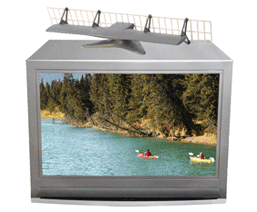You will still need an antenna to continue watching free, over-the-air television after the transition to DTV.
Generally, the same antenna that currently provides good quality reception on an analog TV set will also provide good DTV reception, but this is not always the case. The type of antenna you need for digital reception depends on several factors, including how far you are from the transmitting station, where your antenna is located and in which frequency band (VHF or UHF) the stations are that you want to watch.
After June 12, 2009, some stations will be moving to a different frequency band, so you should check whether that is the case in your area before deciding which type of antenna you need.
To learn which frequency band the stations you watch are in, type in your address and zip code at www.antennaweb.org. This is also a helpful resource for finding an outdoor antenna that will continue giving you free local broadcast programming.

Will I still need an antenna to receive DTV over-the-air?
Yes, you will still need an antenna to continue watching free, over-the-air television after the digital transition. In general, the same type of antenna that gives you good quality analog TV signals now will also provide reliable DTV reception. After June 12, 2009, some television stations will be moving to a different channel in a
different frequency band, which may require you to get another type of antenna from the one you are using. To help determine which outdoor antenna is best for you, visit
www.antennaweb.org.

What do VHF and UHF stand for?
There are two types of frequency bands: VHF and UHF. VHF stands for Very High Frequency and includes channels 2-13. UHF stands for Ultra High Frequency and includes channels 14-51.

In which frequency band are digital TV stations?
Most DTV stations use channels in the UHF band, although some are in the VHF band.

How do I know which antenna to buy?
Since most DTV stations use channels in the UHF band, you will likely need an antenna that can receive UHF signals. But if any stations in your area broadcast on VHF, then you will need a combination VHF/UHF antenna. Receiving VHF and UHF requires different types of antennas. If your existing antenna is VHF-only, then you will need to replace it.

How does a station moving to a new frequency band affect me?
After the transition, some TV stations may move to another channel in a different frequency band, which would require you to get another type of antenna than the one you use now. For example, a station in the "VHF band" (channels 2-13) could move to a channel in the "UHF band" (channels 14-51) and vice versa. Receiving VHF and UHF signals require different antenna types, although some antennas are designed to get both VHF and UHF signals.
Remember to rescan your converter box and TV set for new channels after June 12, 2009, to ensure that you pick up all of the digital stations broadcasting in your area.

 Get Your Converter Box
Get Your Converter Box
 Frequently Asked Questions
Frequently Asked Questions
 News & Multimedia
News & Multimedia